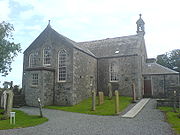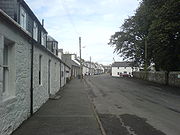
Mochrum
Encyclopedia



Parish
A parish is a territorial unit historically under the pastoral care and clerical jurisdiction of one parish priest, who might be assisted in his pastoral duties by a curate or curates - also priests but not the parish priest - from a more or less central parish church with its associated organization...
in Wigtownshire
Wigtownshire
Wigtownshire or the County of Wigtown is a registration county in the Southern Uplands of south west Scotland. Until 1975, the county was one of the administrative counties used for local government purposes, and is now administered as part of the council area of Dumfries and Galloway...
on the west of the Machars
Machars
The Machars is a peninsula in Galloway in the south-west of Scotland. The word is derived from the Gaelic word Machair meaning low lying or level land, known as "links" on the east coast of Scotland...
peninsula, Dumfries and Galloway
Dumfries and Galloway
Dumfries and Galloway is one of 32 unitary council areas of Scotland. It was one of the nine administrative 'regions' of mainland Scotland created in 1975 by the Local Government etc. Act 1973...
, Scotland
Scotland
Scotland is a country that is part of the United Kingdom. Occupying the northern third of the island of Great Britain, it shares a border with England to the south and is bounded by the North Sea to the east, the Atlantic Ocean to the north and west, and the North Channel and Irish Sea to the...
. It has a population of about 125 which is considerably lower than the population of about 150 years ago. It lies 3.1 km north of the small fishing village of Port William and 14.3 km southwest of Wigtown
Wigtown
Wigtown is a town and former royal burgh in the Machars of Galloway in the south west of Scotland. It lies south of Newton Stewart and east of Stranraer. It has a population of about 1,000...
. The parish was described by its minister in 1838 as "bleak but healthful".
Village
The village consists of a Main Street, a long row of mostly large, terraced cottages dating back to the 1800s, and Mote Brae, a row of eight semi-detached formerly council-owned houses built in the early 1930s. There is evidence of another 'street' running along the line of the back gardens of the current main street houses. This may have been the original main street as the buildings found here show evidence of having been lived in (although now are almost entirely converted into sheds and garages) and are considerably older than the houses of the current Main Street). The oldest house in the village to still be in use is the old gravedigger's cottage adjacent to the kirk gates (although at this time, the author doesn't have a date for this house). The village's centrepiece is provided by the GeorgianGeorgian architecture
Georgian architecture is the name given in most English-speaking countries to the set of architectural styles current between 1720 and 1840. It is eponymous for the first four British monarchs of the House of Hanover—George I of Great Britain, George II of Great Britain, George III of the United...
kirk building, which dates back to 1794 and is a prime example of Scotland's post-Reformation
Scottish Reformation
The Scottish Reformation was Scotland's formal break with the Papacy in 1560, and the events surrounding this. It was part of the wider European Protestant Reformation; and in Scotland's case culminated ecclesiastically in the re-establishment of the church along Reformed lines, and politically in...
ecclesiastical architecture. The church is built on the site of (and using the walls of) a previous church building which dates back to the 12th Century. The former building was largely destroyed by fire in the 1770s but the current building uses most of the former building's rectangular walls in its construction. The current building was originally also rectangular in shape but was substantially altered sometime around 1840. The former Manse (the minister's residence), once provided a hotel for the village (The Green Mantle Hotel - originally opened as such in the early 1970s by Mr Don Carr) but, after changing hands when Mr Carr retired, was sold again, in the late 1990s and has unfortunately been allowed to fall into neglect. It has recently been purchased and the new owners intend it to be refurbished and used as their private residence. The village once boasted: an Inn (The George, which stood outside the main gates of the church and is now a private residence), a Hotel (The Green Mantle see above), a Post Office and grocer's shop (which is now a private residence), a school (which is now a private residence), a blacksmith's (which is now a private residence) and a joiner/undertaker's which is still in business today.
Parish
A number of farms and scattered cottages, though outside the village, come within Mochrum parish, as does the village of Port William and the clachanClachan
A clachan is a type of small traditional settlement common in Ireland and Scotland until the middle of the 20th century. It is usually defined as a small village lacking a church, post office, or other formal building. Their origin is unknown, but it is likely that they are of a very ancient...
of Elrig
Elrig
Elrig is a Clachan in Dumfries and Galloway, Scotland. Located in the Machars peninsula, about 3 miles north of Port William.Elrig is the birthplace of author and naturalist Gavin Maxwell, who was born at the House of Elrig. His boyhood is recounted in The House of Elrig, published in 1965...
. Druchtag Motehill, a steep-sided mound and site of a 12th-century motte-and-bailey castle lies about 100m north west of Mote Brae. Mochrum parish is also the site of many prehistoric forts, including the Mesolithic Barsalloch Fort, and many earthworks, standing stones, and crannógs, as well as both early and medieval crosses.

